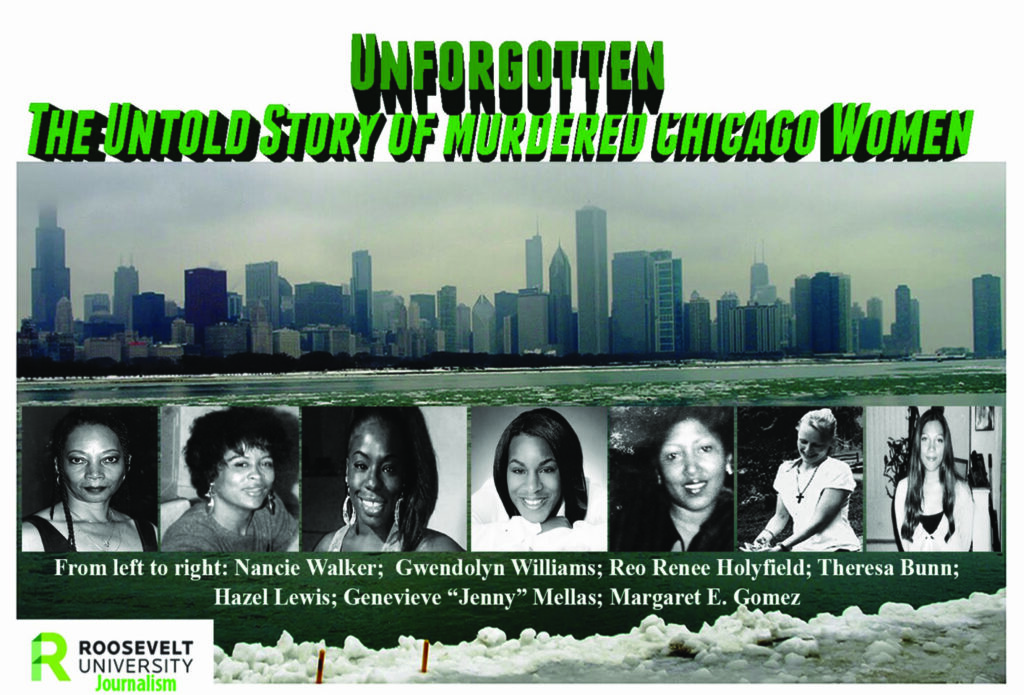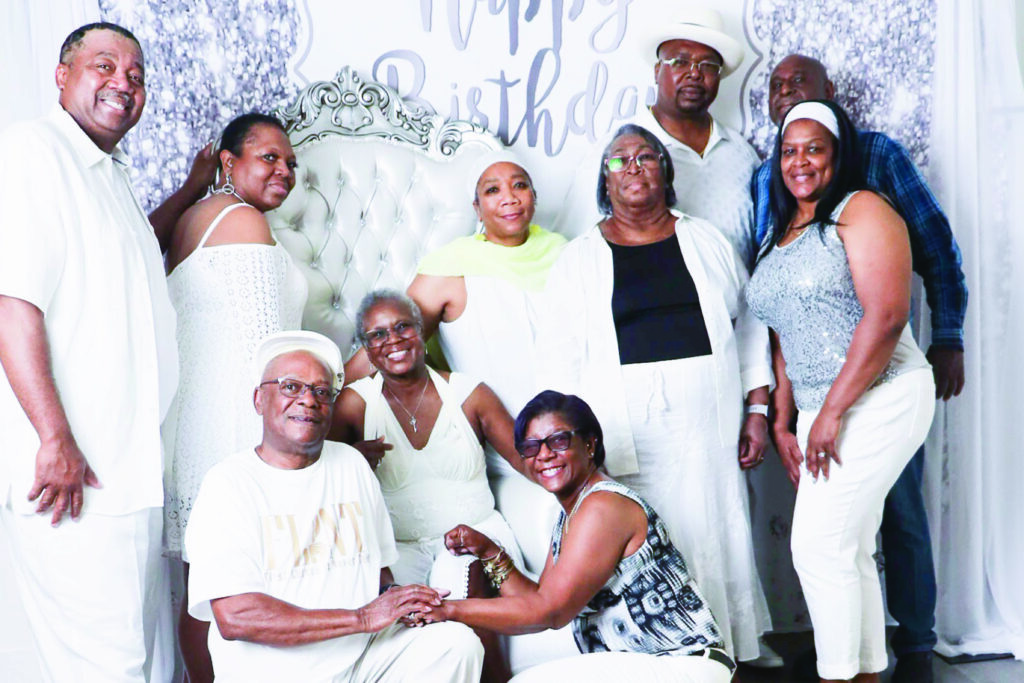Photo caption: A portrait of Linda Green (Jeannie). (Photo: Provided by family)
Sounding The Alarm – Part III
Charles Green hopped into his light burgundy 1989 Nissan 240SX with spotless chrome rims, on a quest from Kalamazoo, Michigan, to Chicago on a late-spring day 20 years ago with one purpose: To find his big sister, Linda. His wheels turned over the 146 mile-journey. He was in his thirties then, handsome, and like their family, worried after receiving a telephone call from Linda’s boyfriend over in the Windy City, saying that he hadn’t heard from her in two weeks. Plus, they hadn’t heard from her on her birthday, June 2. She always called home. This wasn’t like her at all. It was cause for concern.
Being the closest in proximity to Chicago among their close-knit family, there was no other option for Charles, Linda’s baby brother, but to hit the road. Upon his arrival, Charles picked up a friend and drove around the city in search of Linda, twin sister to their brother Calvin. They drove up and down streets where she was known to hang out, searching, hoping for any sign of his 5-foot-2-inch sister who always wore a short-tapered Afro with a widow’s peak that accentuated her smooth chocolate skin and full face, round cheeks, and deep brown eyes. But there was no sign of Linda. The brother continued his search, stopping at friends of Linda’s, at her usual spots. Still, there was no sign, no answers.
Having searched what seemed to be everywhere, Green had one last hope. He drove to a police station. There he gave an officer his sister’s name. Linda… Linda Green. She was 42.
Soon Charles would have an answer, though it was hardly the one he had hoped for.
A short while later, he arrived with police at the Cook County Medical Examiner’s Office. He was escorted to a room inside the morgue. There he stood over a body draped in a sheet. “That couldn’t be Linda,” he thought to himself, though uttering no words. As the coroner pulled the sheet back, Green, 6 feet 2 inches tall, stared down at the brown body of a female that had been badly bruised.
“When they pulled the sheet back, it shocked me,” Green recalls, now two decades later. “It looked like her face was swollen, a couple knots on her head.
“I didn’t want to believe it was my sister ‘til I saw her.”
It was indeed her.
An untold number of Black and brown women go missing or are murdered each year, according to researchers, analysts, women advocacy groups and others who contend that the color of a female victim’s skin matters in America. And the extent to which it matters, many observers say, is reflected in the lack of media attention the cases of Black and other women of color receive compared to the cases of white women. Such disparity, they contend, is also evident in the not-so-easily quantifiable number of those cases—the missing and the murdered—that each year go unsolved and that amount to a rising sea of carnage that one report has labeled, in part, “an unspoken epidemic.”

This much is clear and calculable: That from 2019 through 2021 alone, 5,240 Black women and girls were killed with the 2,078 homicides recorded in 2021 representing a nearly 54 percent increase since 2019, according to the Centers for Disease Control and Prevention. That the homicides of Black women and girls outpaced the number of homicides overall nationwide, which rose comparatively by 36 percent during that same time period, the latest CDC figures show.
That missing Black females and males in 2022, according to the National Crime Information Center, accounted for 35 percent of a total 546,568 missing persons cases, despite Blacks comprising only 13.6 percent of the U.S. population. Of the total number of Blacks reported missing, 97,924, or more than 50 percent, were Black females; 95,194 were Black males; and there were 33 missing Black persons for whom gender was unknown.
Behind the numbers are the flesh and blood, heart and soul, and excruciatingly painful stories of victims and also their families. Their agony, families and analysists say, is often exacerbated by the belief that the color of their loved one’s skin makes their cases less palatable for mainstream news media, and much less likely to receive the attention and resources of law enforcement that would lead to more of these cases being solved.
For many families, there is no word for days, weeks, months, years, if ever, about the whereabouts of missing loved ones. For some, like the family of Linda Green, there is no call from police, even after decades, that they have finally identified a suspect in the murder.
Such cases, analysts say, are less likely to stir public outcry and more likely to grow colder and colder each year as families, hoping for answers and justice, are left with only more questions, and no solace.
The Green family is among thousands. And their story is a microcosm of the near inconsolable journey of losing a loved one to murder, of the effort to have their stories humanized and unforgotten, no matter how much time passes, no matter their lingering pain.
The Case For Race
Linda Green was found murdered, at 6804 S. South Chicago Ave., on May 20. 2003. Her case is among 51 mostly African-American women murdered by strangulation in Chicago from 2001 to 2018, whose bodies were deposited in alleys, trash bins mainly on the city’s West and South Sides.
The murders are believed by one analyst to potentially be the work of at least one serial killer. That organization, the Alexandria, Virginia-based Murder Accountability Project, which uses a computer algorithm to track serial murders, has alerted the media and Chicago police about their findings, although police have publicly refuted the idea that the cases are linked to a serial killer.
The Green family isn’t so sure and were shocked recently to learn that their sister is among a group of other women whose cases may be related.
Amanda Dudley, 57, Green’s sister, remembers vividly the day in 2003 when she and her husband drove from their home in Flint, Michigan, to the Dixon Correctional Center in Dixon, Illinois, to notify her nephew Nathan, Green’s only child, that his mother had been murdered.
“In order to make sure that he didn’t find out secondhand from anyone else or on the news, my husband and I went to tell him,” Dudley recalls. “He was just angry, jumping up, cursing, wondering how it happened. He was angry then and is still somewhat angry now.”
For the family, neither their anger nor their brokenness have dissolved after all these years. And pieces of the puzzle of what may have happened to their sister, or questions that still linger, even information about the case, sometimes seems to come out of nowhere. In fact, last year, Dudley sat in her home, watching television when suddenly the words “Linda Green” appeared on the screen, along with “May 20, 2003,” the date her body was found.
In a flash, Dudley was reminded of the horror in a three-part docuseries on Discovery+ titled, “The Hunt For The Chicago Strangler.” It was the first time the family had been made aware of Green’s possible connection to a group of murdered women in Chicago. In shock, Dudley rushed to call her siblings.
“You know how I found out about this? I was watching TV, and the show came on, and her name was on the screen,” Dudley says. “That’s how we found out about the 51 victims because we saw a show with her name and a date.”
The Green family is still in pursuit of answers. They say they have not, however, received any updates from law enforcement officials regarding their sister’s murder.
“No one told us anything. They never connected to say, ‘Ok, this is what’s happening in the city and that she is part of this,’” says Dudley.
At one time, the family says they routinely called police. But the police would say they had no answers. We’ll let you know when we find out anything. We’ll let you know, is all they would say.
Then eventually, the family would call police, they say. Except police stopped answering.
“The phone would just ring…” Green’s older sister, Hattie Green, 72, says. “I haven’t heard anything since.”
Contacted twice by email, the Chicago police News Affairs office did not respond to a reporter’s recent request for information in the case of the 51 Chicago women identified by the Murder Accountability Project as being possibly committed by at least one serial killer.
Charles Green, believes that race is undeniably the sole reason his family has remained uninformed about any leads, developments or news in his sister’s case. And that race is the reason the cases of Black women don’t receive the same news media hype and attention.
“Do you think if these were 51 white women this would’ve happened? This would’ve been all on CNN and everywhere,” Green says.
The siblings as a collective say it would be a different story if their sister was white.
Absence Does Not Make The Heart Grow Fonder
They call her Jeannie.
In the midst of grief, the Green siblings find solace in reflecting on memories of their sister. Growing up in Idlewild, Michigan—“Black Eden,” a historic resort town and safe-haven for African Americans once frequented by the rich and famous—they were close-knit. They were each other’s keeper in the small town where everyone knew if you messed with one of the Greens, then you had to deal with all of them. Their sister Linda was leader of the pack, their protector and shield.

“Jeannie was a twin and she was definitely one of our strongest protectors. She would fight at the drop of a hat,” Dudley says, laughing. “You didn’t have to worry about anything when she was around.
“If she caught wind that someone was trying to bully us, or any rumors of anyone saying anything, that’s all it took for her to go into full-blown beat-down mode,” Dudley adds.
Growing up, the Green family didn’t always have a lot, but they were rich in family, love and values, Charles Green recalls.
“We had a wonderful childhood. My mother did all she could for us,” he says. “We didn’t know we were poor until she told us when we got older because we didn’t miss anything. We always laugh about it now, but she did the best she could with what she had.”
In spite of hard times, their mother ensured that her 12 children would not only have basic necessities but all that she could give. “We always had three to four meals a day, clean clothes, bikes, and material things,” Charles Green says, reflecting on his childhood.
“We grew up in church, and all of us had to graduate from high school, whether you liked it or not,” Green adds. “Some went on to college and some didn’t, but you had to graduate from high school, that was a must.”
To Charles, Linda was the cool big sister every sibling longed to have, ensuring that he was “fresh” and had all the necessary attire as a high schooler, even if money was tight.
“My mom didn’t really have a lot of money. I played sports in high school, so Jeannie went out and got a job and bought me some gym shoes because my mom couldn’t afford them. She made sure her brother had some name-brand gym shoes. Of course, she reminded me as we got older,” Green says laughing.
As her younger siblings grew, Linda scored cool points with her sister Amanda. In 1984, Amanda was a senior at Baldwin High School and needed an accomplice for senior day.
“It was senior skip day,” she recalls, laughing like a schoolgirl, memories of her murdered sister rushing back in living color. “We were having our festivities at a house on a lake.
“We needed alcohol and none of us were of age,” she continues. “So we called my sister Jeannie who helped us out with that. She hooked up our whole class and it was a memorable skip day.”
The Green family says they miss their sister most during the holidays and also on her birthday. It is a tradition for the siblings to gather at their old home on momentous occasions.
“She just loved to laugh and be happy,” Hattie Green says, laughing, even if she is after all these years still hurting.
Epilogue
Recently, Charles Green reminisced about his quest to find his sister that day. About going from building to building, and scanning the street for any sign of her, only to find her lying on a table inside the coroner’s office. The details and pain are still fresh after two decades. His detailed revelations, spoken to a reporter in front of his family during an interview, were something he had kept from his sisters after all this time.
Green explains that he had shielded his sisters from knowing that Jeannie had been brutally murdered. After viewing the body at the morgue, he stayed in Chicago that night, wrestling with the horror of what he had just witnessed and contemplating whether he should ever share it with his siblings.
“I was just concerned about the girls,” he explains. “I didn’t want to tell them how I saw her. I just called them and said, ‘This is Jeannie.’ I couldn’t tell my sisters the state that I (had) seen her in.”
Instead he chose to protect his family the best way he thought he could by choosing to bear that burden alone.
“No, you didn’t tell us that,” two of the sisters remark during an interview, as pieces of their sister’s murder they had never known become clear. That there were no details of how and where she was found. No police report.
Days before completion of this project, however, this reporter’s Freedom of Information Act request, filed with Chicago Police for a police report that might finally bear more answers for the Green family, was received. The report is a clear copy, written in an officer’s penmanship in all caps, and marked with an official header that reads “Hospitalization Case Report/ Chicago Police.” Its details are unsettling but exact:
A body was found in a “wooded alley” on May 20, 2003. Time: 1705.
Officers responded to “a call of a person.” Of a lifeless body. It was D.O.A. upon the officers’ arrival.
Special Agent Sandberg of the Norfolk Southern Railway Police department directed Chicago police officers to the body. Officers “found the victim’s body face down and unclothed…”
“The victim’s clothes were scattered about the scene. The victim was identified via a I.D.P.A. (Illinois Department of Public Aid) identification card found in her clothing by Sandberg… Cause of death could not yet be determined.
“Notifications made and the body transported to M.E.” (The Cook County morgue.)
That is where the brother who had set out on a 146-mile journey in search of his big sister that late-spring day in May, 20 years ago, finally found her.
Recently, Green and his family expressed gratitude for the revelations provided by the police report as yet another piece of this still unsolved puzzle, no matter how painful—deeply painful for her twin brother Calvin who longs for answers of what happened to his beloved sister.
But for the family, much still remains unclear. After all these years, there are still no suspects. No motive. No new developments. No answers. No justice. And no solace.
“I think about her every day,” Charles Green, now 58, says of his sister Jeannie. “She wouldn’t want us to sit here and mope. She would want us to go on with our lives, do something positive, and also bring the person who did this to justice.”
Chicago Police say the case remains open. Like this family’s wound.






